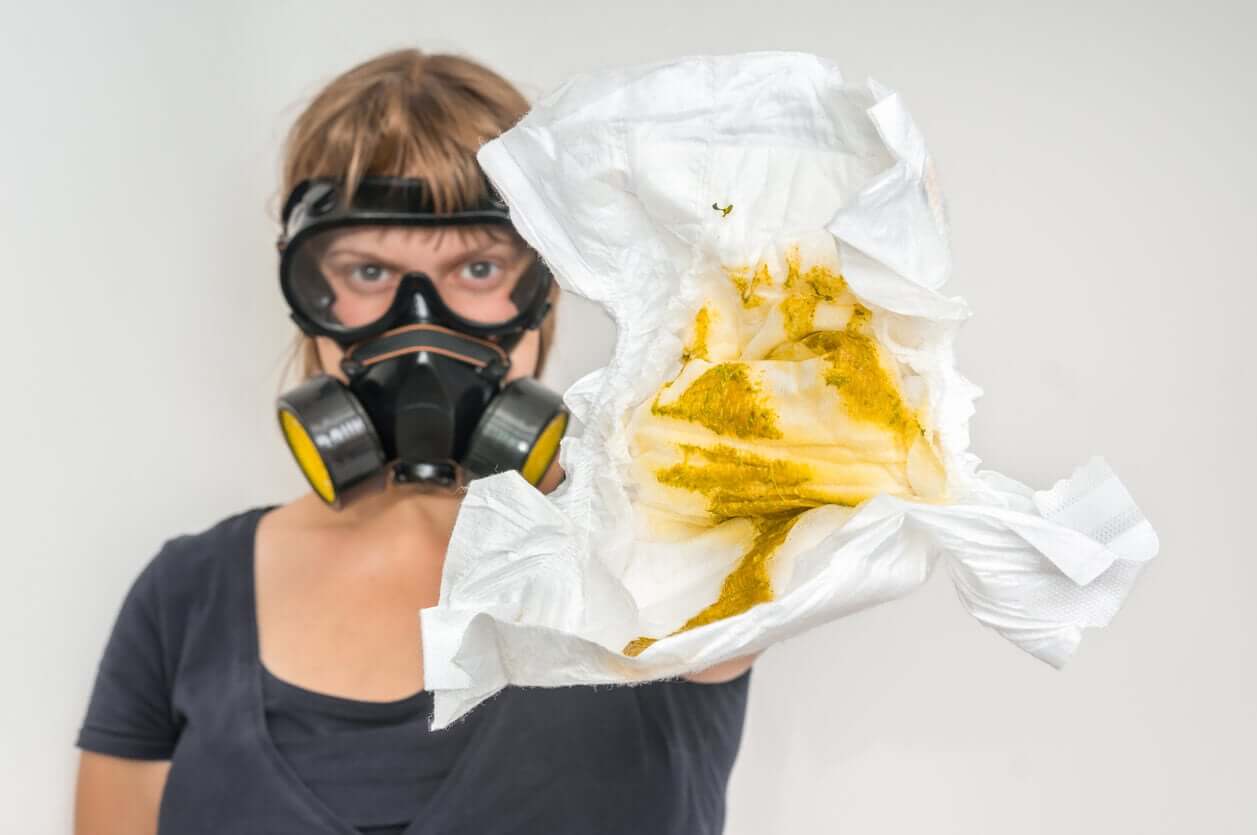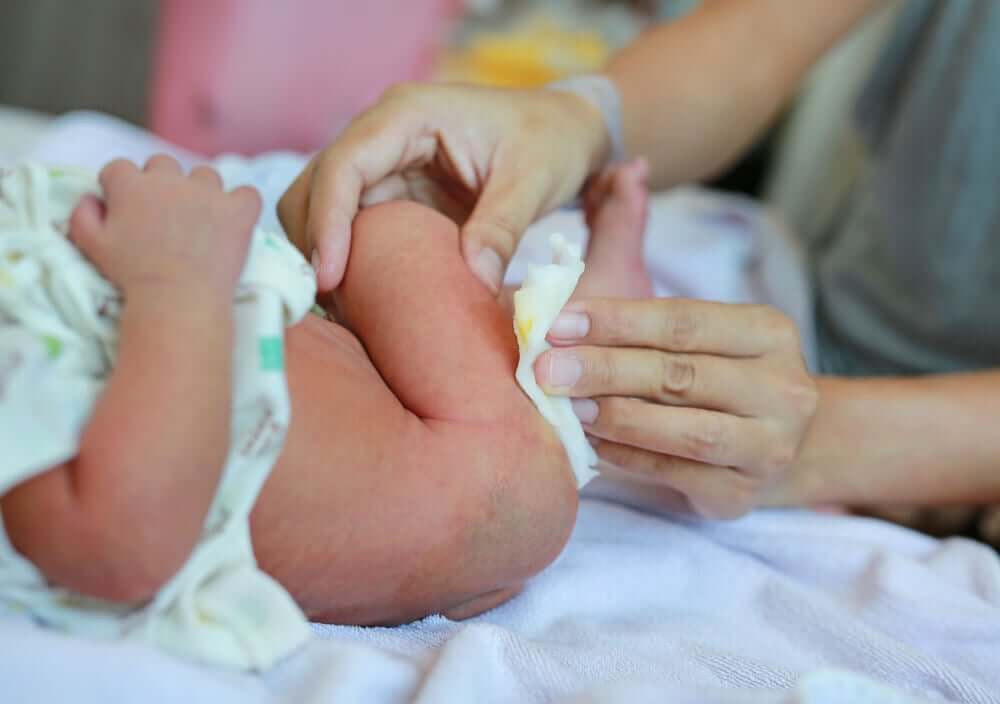Bloody Stools in Babies: What You Need to Know

Changes in a baby’s stool rarely go unnoticed, especially when accompanied by blood or other noticeable signs. Although the presence of this body fluid isn’t normal, it doesn’t always imply a serious illness. However, it’s important to consult with a pediatrician in order to detect what the cause is. Below, we’ll describe the most common causes of bloody stools in babies and when they represent an emergency.
Babies’ stools and their normal characteristics
Throughout the first year of life, the feces of children vary due to multiple factors. These changes can occur both in consistency, color, or frequency.
In general, newborns have a thick, black poop in the first hours of life, called meconium. Then, as lactation sets in, the stool turns yellowish and the consistency is a bit runnier.
Around the sixth month, with the introduction of complementary feeding, the consistency increases a little more and the color of the poop tends to become darker. Just the same, the characteristics of the stools vary according to the little one’s diet.
Warning signs in babies’ stools
Despite these physiological variations, usually pediatricians counsel parents about the signs of alarm in the feces of babies. These are the following:
- The absence of meconium elimination during the first 24 hours of life.
- In breastfed newborns, bowel movements less than once a day for the first few weeks.
- Large, hard, and dry poop that the baby finds it difficult to expel.
- A striking increase in the number of daily poops.
- The presence of greyish-white poop, accompanied by yellowing of the skin (jaundice).
- Red or black poop, with an unpleasant odor, outside the meconium period.
- The presence of worms, mucus, blood, or pus.

Bloody stools in babies: What do they represent?
As a general guideline, whenever blood appears in the stool, you need to consult a pediatrician. Blood can appear as thin stretch marks, in the form of drops or larger clots, or even as heavy bleeding through the baby’s anus.
In addition to the usual bright red appearance, blood can appear in other less common ways in the stool, and it’s important to be aware of them so as not to misinterpret this finding.
Depending on what the bloody stools look like, you can infer where they come from:
- Stools with red blood: They usually indicate bleeding in the last portion of the intestine and even from the organs near the anal opening (such as the vagina or skin). This is known as hematochezia.
- Dark, blackish, and foul-smelling stools: Stools adopt this color due to the digestion of blood with stomach acid and usually indicate high digestive bleeding (from the esophagus to the beginning of the intestine). This type of bleeding is known as melena.
- Brown, abundant, jelly-like blood: Known as “currant jelly clots” and represents a critical clinical condition. It usually indicates an illness at the level of the small intestine or the junction between the small intestine and the colon (intussusception).
The 8 Most Common Causes of Blood in Babies’ Stools
Digestive bleeding can occur for different reasons and these vary in frequency depending on the age of the child. Next, we’ll mention the most common causes of blood in baby stools:
- Anal fissures: These are lesions of the skin or the mucosa surrounding the anus, which occur as a result of the passing of hard stools. In general, they produce red blood streaks and discomfort after defecation.
- Diaper Rash: Although they don’t strictly cause digestive bleeding, severe skin lesions in the diaper area can cause bloodstains, sometimes intermingled with stool.
- Allergy to cow’s milk protein: This is colitis that causes inflammation of the walls of the baby’s intestine after contact with a component of cow’s milk. It can manifest itself from light or heavier bleeding, but in all cases, it’s possible to confirm the diagnosis through specific studies.
- Pseudo menstruation in newborn babies: This occurs as a consequence of the maternal passing of hormones through the placenta. As in puberty, some girls have vaginal bleeding that can be confused with digestive bleeding. It’s a transitory phenomenon that resolves itself.
- Necrotizing enterocolitis: This is a potentially serious disease that affects premature newborns.
- Infectious colitis: Although a rare cause in young babies, food poisoning often occurs from improper handling of food. Some of the microorganisms that produce them generate inflammation in the walls of the intestine and give rise to bloody stools.
- Intussusception: As mentioned previously, it’s produced by the introduction of one intestinal segment into another. It’s a potentially serious condition that requires urgent evaluation.
- Meckel’s diverticulum: This is a congenital defect of the intestinal walls that makes them more prone to bleeding. In general, it manifests itself in the first 2 years of life, as painless massive bleeding (Kamath, 2008).

When do you have to seek emergency medical attention?
As we’ve mentioned, when blood is detected in the stool, you need to consult your family pediatrician. However, this isn’t always life-threatening or urgent.
For this reason, it’s important to know what signs or symptoms merit a visit to an emergency center when intestinal bleeding is suspected:
- The child’s in poor condition in general (down, with a tendency to sleep, is agitated).
- Heavy or repeated bleeding in the diaper.
- Bloody or dark vomiting.
- Pale skin or mucous membranes (eyes or mouth).
- Severe abdominal pain
- Irritability, which may alternate with periods of a tendency to sleep (alternating sensory).
- Refusal of food or difficulties with hydration.
Changes in a baby’s stool rarely go unnoticed, especially when accompanied by blood or other noticeable signs. Although the presence of this body fluid isn’t normal, it doesn’t always imply a serious illness. However, it’s important to consult with a pediatrician in order to detect what the cause is. Below, we’ll describe the most common causes of bloody stools in babies and when they represent an emergency.
Babies’ stools and their normal characteristics
Throughout the first year of life, the feces of children vary due to multiple factors. These changes can occur both in consistency, color, or frequency.
In general, newborns have a thick, black poop in the first hours of life, called meconium. Then, as lactation sets in, the stool turns yellowish and the consistency is a bit runnier.
Around the sixth month, with the introduction of complementary feeding, the consistency increases a little more and the color of the poop tends to become darker. Just the same, the characteristics of the stools vary according to the little one’s diet.
Warning signs in babies’ stools
Despite these physiological variations, usually pediatricians counsel parents about the signs of alarm in the feces of babies. These are the following:
- The absence of meconium elimination during the first 24 hours of life.
- In breastfed newborns, bowel movements less than once a day for the first few weeks.
- Large, hard, and dry poop that the baby finds it difficult to expel.
- A striking increase in the number of daily poops.
- The presence of greyish-white poop, accompanied by yellowing of the skin (jaundice).
- Red or black poop, with an unpleasant odor, outside the meconium period.
- The presence of worms, mucus, blood, or pus.

Bloody stools in babies: What do they represent?
As a general guideline, whenever blood appears in the stool, you need to consult a pediatrician. Blood can appear as thin stretch marks, in the form of drops or larger clots, or even as heavy bleeding through the baby’s anus.
In addition to the usual bright red appearance, blood can appear in other less common ways in the stool, and it’s important to be aware of them so as not to misinterpret this finding.
Depending on what the bloody stools look like, you can infer where they come from:
- Stools with red blood: They usually indicate bleeding in the last portion of the intestine and even from the organs near the anal opening (such as the vagina or skin). This is known as hematochezia.
- Dark, blackish, and foul-smelling stools: Stools adopt this color due to the digestion of blood with stomach acid and usually indicate high digestive bleeding (from the esophagus to the beginning of the intestine). This type of bleeding is known as melena.
- Brown, abundant, jelly-like blood: Known as “currant jelly clots” and represents a critical clinical condition. It usually indicates an illness at the level of the small intestine or the junction between the small intestine and the colon (intussusception).
The 8 Most Common Causes of Blood in Babies’ Stools
Digestive bleeding can occur for different reasons and these vary in frequency depending on the age of the child. Next, we’ll mention the most common causes of blood in baby stools:
- Anal fissures: These are lesions of the skin or the mucosa surrounding the anus, which occur as a result of the passing of hard stools. In general, they produce red blood streaks and discomfort after defecation.
- Diaper Rash: Although they don’t strictly cause digestive bleeding, severe skin lesions in the diaper area can cause bloodstains, sometimes intermingled with stool.
- Allergy to cow’s milk protein: This is colitis that causes inflammation of the walls of the baby’s intestine after contact with a component of cow’s milk. It can manifest itself from light or heavier bleeding, but in all cases, it’s possible to confirm the diagnosis through specific studies.
- Pseudo menstruation in newborn babies: This occurs as a consequence of the maternal passing of hormones through the placenta. As in puberty, some girls have vaginal bleeding that can be confused with digestive bleeding. It’s a transitory phenomenon that resolves itself.
- Necrotizing enterocolitis: This is a potentially serious disease that affects premature newborns.
- Infectious colitis: Although a rare cause in young babies, food poisoning often occurs from improper handling of food. Some of the microorganisms that produce them generate inflammation in the walls of the intestine and give rise to bloody stools.
- Intussusception: As mentioned previously, it’s produced by the introduction of one intestinal segment into another. It’s a potentially serious condition that requires urgent evaluation.
- Meckel’s diverticulum: This is a congenital defect of the intestinal walls that makes them more prone to bleeding. In general, it manifests itself in the first 2 years of life, as painless massive bleeding (Kamath, 2008).

When do you have to seek emergency medical attention?
As we’ve mentioned, when blood is detected in the stool, you need to consult your family pediatrician. However, this isn’t always life-threatening or urgent.
For this reason, it’s important to know what signs or symptoms merit a visit to an emergency center when intestinal bleeding is suspected:
- The child’s in poor condition in general (down, with a tendency to sleep, is agitated).
- Heavy or repeated bleeding in the diaper.
- Bloody or dark vomiting.
- Pale skin or mucous membranes (eyes or mouth).
- Severe abdominal pain
- Irritability, which may alternate with periods of a tendency to sleep (alternating sensory).
- Refusal of food or difficulties with hydration.
All cited sources were thoroughly reviewed by our team to ensure their quality, reliability, currency, and validity. The bibliography of this article was considered reliable and of academic or scientific accuracy.
- Asociación Española de Pediatría (2023). Protocolos diagnósticos y terapéuticos en Gastroenterología, Hepatología y Nutrición Pediátrica. Protocolos de la AEP. https://www.aeped.es/sites/default/files/documentos/13-HDB.pdf.
- Bonilla, E., Ramírez, L., Rojas, P., & Zúñiga, B. (2020). Enterocolitis necrotizante. Medicina Legal de Costa Rica, 37(2), 63-70. http://www.scielo.sa.cr/scielo.php?script=sci_arttext&pid=S1409-00152020000200063&lng=en&tlng=es.
- Kamath, B. K., Mamula, P. (2008). Gastrointestinal bleeding. Pediatric Gastroenterology: The Requisites in Pediatrics. Mosby.
- Pai, A. K., Fox, V. L. (2017). Gastrointestinal Bleeding and Management. Pediatr Clin North Am, 64(3), 543-561. https://pubmed.ncbi.nlm.nih.gov/28502437/.
- Ramos, J., Camarero, C. ()
- Schmitt, B. Symptomviewer: Taburetes – Color Inusual. Consultado el 17 de mayo de 2023. https://www.healthychildren.org/English/tips-tools/symptom-checker/Pages/symptomviewer.aspx?symptom=Stools%20-%20Unusual%20Color.
- Storch, P. Cacas de los bebés. Consultado el 17 de mayo de 2023. https://enfamilia.aeped.es/edades-etapas/cacas-bebes.
- Mayo Clinic. (2022). I’m breastfeeding my newborn and my baby’s bowel movements are yellow and mushy. Is this normal for baby poop?. Consultado el 23 de mayo de 2023. https://www.mayoclinic.org/es-es/healthy-lifestyle/infant-and-toddler-health/expert-answers/baby-poop/faq-20057971
This text is provided for informational purposes only and does not replace consultation with a professional. If in doubt, consult your specialist.








